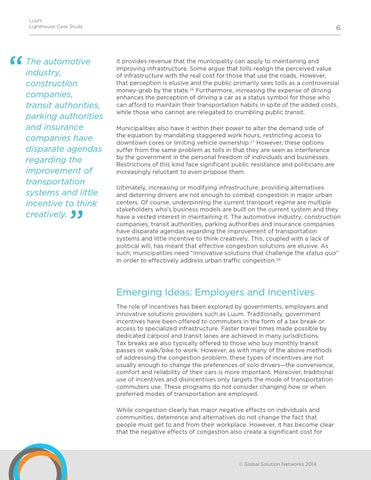Luum Lighthouse Case Study
“
The automotive industry, construction companies, transit authorities, parking authorities and insurance companies have disparate agendas regarding the improvement of transportation systems and little incentive to think creatively.
”
6
it provides revenue that the municipality can apply to maintaining and improving infrastructure. Some argue that tolls realign the perceived value of infrastructure with the real cost for those that use the roads. However, that perception is elusive and the public primarily sees tolls as a controversial money-grab by the state. 26 Furthermore, increasing the expense of driving enhances the perception of driving a car as a status symbol for those who can afford to maintain their transportation habits in spite of the added costs, while those who cannot are relegated to crumbling public transit. Municipalities also have it within their power to alter the demand side of the equation by mandating staggered work hours, restricting access to downtown cores or limiting vehicle ownership. 27 However, these options suffer from the same problem as tolls in that they are seen as interference by the government in the personal freedom of individuals and businesses. Restrictions of this kind face significant public resistance and politicians are increasingly reluctant to even propose them. Ultimately, increasing or modifying infrastructure, providing alternatives and deterring drivers are not enough to combat congestion in major urban centers. Of course, underpinning the current transport regime are multiple stakeholders who’s business models are built on the current system and they have a vested interest in maintaining it. The automotive industry, construction companies, transit authorities, parking authorities and insurance companies have disparate agendas regarding the improvement of transportation systems and little incentive to think creatively. This, coupled with a lack of political will, has meant that effective congestion solutions are elusive. As such, municipalities need “innovative solutions that challenge the status quo” in order to effectively address urban traffic congestion. 28
Emerging Ideas: Employers and Incentives The role of incentives has been explored by governments, employers and innovative solutions providers such as Luum. Traditionally, government incentives have been offered to commuters in the form of a tax break or access to specialized infrastructure. Faster travel times made possible by dedicated carpool and transit lanes are achieved in many jurisdictions. Tax breaks are also typically offered to those who buy monthly transit passes or walk/bike to work. However, as with many of the above methods of addressing the congestion problem, these types of incentives are not usually enough to change the preferences of solo drivers—the convenience, comfort and reliability of their cars is more important. Moreover, traditional use of incentives and disincentives only targets the mode of transportation commuters use. These programs do not consider changing how or when preferred modes of transportation are employed. While congestion clearly has major negative effects on individuals and communities, deterrence and alternatives do not change the fact that people must get to and from their workplace. However, it has become clear that the negative effects of congestion also create a significant cost for
© Global Solution Networks 2014
